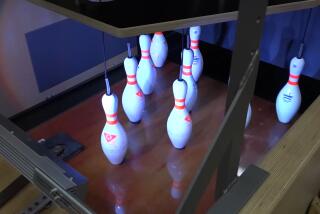GAMES : Electronic Darts: Get the Point?
- Share via
Good news for people who love parlor games but have trouble balancing their checkbooks: Darts has finally been dragged into the computer age.
Yes, the venerable British pub sport that for so many, many years required not only a sharp eye and a steady hand, but also quick arithmetic ability, has entered the age of the pocket calculator.
Only a few years ago, the game still worked like this: You stood at a line 7 feet, 9 1/4 inches away from a bristle dart board mounted on a wall and flung steel-tipped missiles at the board while another player stood nearby at a chalkboard, speedily subtracting your latest score from your previous one. The idea was to start with a score of either 301 or 501 and end exactly on zero by tossing a dart in the proper space in the outer--or “double”--ring of the board.
Today, you can forget the guy at the chalkboard. In fact, you can forget the chalkboard.
Increasingly, at pubs and taverns around Orange County that feature darts as both a pastime and a team sport, the game is being played on an electronic board. And the differences from the more traditional method are at once subtle and profound.
The bull’s-eye of an electronic dart board (which is attached to a console) is, like a bristle board, situated 5 feet, 8 inches off the floor.
In electronic darts, the players throw from a line eight feet from the board, and the inner (or “triple”) ring, outer “double” ring and the inner and outer bull’s-eyes all are larger than they are on the conventional bristle board.
Rather than beginning and ending the game by throwing a dart into the “double” ring (in conventional dart games beginning with a score of 301, subtraction of scores cannot begin until a “double” is thrown), scoring begins with the first dart. The game ends when a player reaches exact zero, but that score need not come by throwing a “double.” In dart talk, this type of game is called “straight in, straight out” rather than “double in, double out.”
The best part, especially for the math-deprived, is that the electronic board keeps score automatically, for every player, and flashes the scores digitally.
Electronic darts, said Stuart Malmgren, owner of a Tustin dart equipment shop called Dart Works, is a money-maker for bar owners because players must feed quarters into it to play--25 cents to 75 cents, depending on the game. However, Malmgren said, electronic dart machines for use in the home range from about $175 to around $700. A bristle board can cost between $40 and $65, Malmgren said.
Electronic darts can cost substantially less than their counterparts in the conventional darting world. They are similar to conventional darts in nearly every respect but the point, which is not sharp steel, but blunt plastic. When thrown at an electronic board, they stick in tiny holes bored in the plastic surface of the board (even if they bounce off, Malmgren said, the score is still recorded automatically).
Steel-tipped darts consist of three parts: the metal barrel (which includes the point), the metal or plastic shaft, which screws into the barrel, and the flight, which is generally made of plastic and fits into the trailing end of the shaft to steady the flight of the dart (flights were originally made of feathers).
The business end, the barrel, determines the price of a set of three darts. Brass-barreled darts can sell for as little as $12 a set. Nickel silver darts vary in the medium price range, and tungsten sets can cost as much as $180, Malmgren said.
Why tungsten? This metal is exceptionally dense and can be fashioned into darts that offer comfortable heft, yet are thin enough to enable the player to throw them into a very tight grouping, Malmgren said.
Plastic-tipped sets, on the other hand, don’t need such thinness, he said, because they don’t have to be grouped as tightly on the more accommodating electronic board. In fact, Malmgren added, the rules of electronic darts don’t allow darts heavier than 16 grams (heavier darts could damage early electronic boards models). Steel-tipped darts can weigh 30 grams or more.
Therefore, plastic-tipped darts usually employ cheaper metals and usually cost between $12 and $40, Malmgren said. However, the plastic tips tend to break and must be replaced fairly often.
Which is a kind of dubious comfort to the game’s bedrock traditionalists, who, said Malmgren, are still numerous in spite of the gains made by the machines. They have their small revenge. According to Malmgren, they enjoy calling the plastic missiles “toy darts.”
More to Read
Go beyond the scoreboard
Get the latest on L.A.'s teams in the daily Sports Report newsletter.
You may occasionally receive promotional content from the Los Angeles Times.









